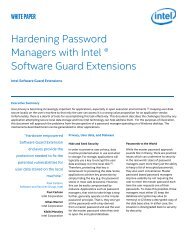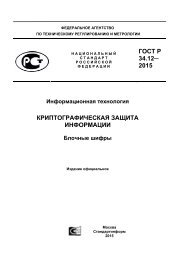ts_103127v010101p
ts_103127v010101p
ts_103127v010101p
You also want an ePaper? Increase the reach of your titles
YUMPU automatically turns print PDFs into web optimized ePapers that Google loves.
11<br />
ETSI<br />
ETSI TS 103 127 V1.1.1 (2013-05)<br />
For applications that scramble MPEG-2 Sections, a problem occurs as the MPEG-2 specified syntax does not include<br />
any scrambling control bi<strong>ts</strong>. Therefore, the scrambling of Sections shall be at the TS level and shall be signalled by the<br />
scrambling control field bi<strong>ts</strong>. Clear and scrambled Sections cannot be combined in a single TS packet. The MPEG-2<br />
defined padding mechanism can be used to create TS packe<strong>ts</strong> with only clear or only scrambled Sections. This means<br />
that the end of a TS packet carrying a Section shall be filled with bytes having a value of 0xFF, in order to separate<br />
clear and scrambled Sections into different TS packe<strong>ts</strong>.<br />
In DVB CISSA context, PES level scrambling is expected to be used only for service-driven professional applications<br />
and is not intended to be used in Consumer Electronics applications.<br />
6.3 Normative Elemen<strong>ts</strong><br />
This clause provides the normative description of CISSA version 1. Notations are as defined in clause 3.2.<br />
6.3.1 Encryption Elemen<strong>ts</strong><br />
6.3.1.1 Block Cipher<br />
AES-128, as defined in NIST FIPS 197 [1], shall be used as underlying block cipher for CISSA.<br />
6.3.1.2 Initialization Vector<br />
The Initialization Vector shall have the following value:<br />
• IV=0x445642544d4350544145534349535341<br />
6.3.1.3 Chaining Mode<br />
CBC, as defined in NIST SP800-38A [2], shall be used as chaining mode.<br />
6.3.2 TS packet Scrambling and Descrambling<br />
Each TS packet shall be processed separately.<br />
The TS packet header and adaptation field, if present, shall be left in the clear.<br />
The payload size (payload_size) and the encrypted payload size (encrypted_payload_size) shall be computed as<br />
follows:<br />
• payload_size = 188 - (header_size + adaptation_field_size)<br />
• encrypted_payload_size = payload_size - [payload_size mod 16]<br />
where header_size is the size of the TS packet header in bytes, and adaptation_field_size is the size of the<br />
adaptation field in bytes.<br />
The encrypted_payload_size bytes immediately following the adaptation field (or, if there is no adaptation field,<br />
following the TS packet header) shall then be encrypted or decrypted using the encryption elemen<strong>ts</strong> as defined in<br />
clause 6.3.1.<br />
Any remaining byte shall be left in the clear.<br />
EXAMPLE 1: If there is no adaptation field; encrypted_payload_size is 176 bytes and there will be 8 bytes at<br />
the end of the TS packet that will remain in the clear.<br />
EXAMPLE 2: If the adaptation field size is 17, encrypted_payload_size is 160 bytes and there will be 7 bytes at<br />
the end of the TS packet that will remain in the clear.<br />
EXAMPLE 3: If the adaptation field size is 24, encrypted_payload_size is 160 bytes and there will be no bytes<br />
left in the clear at the end of the TS packet.





